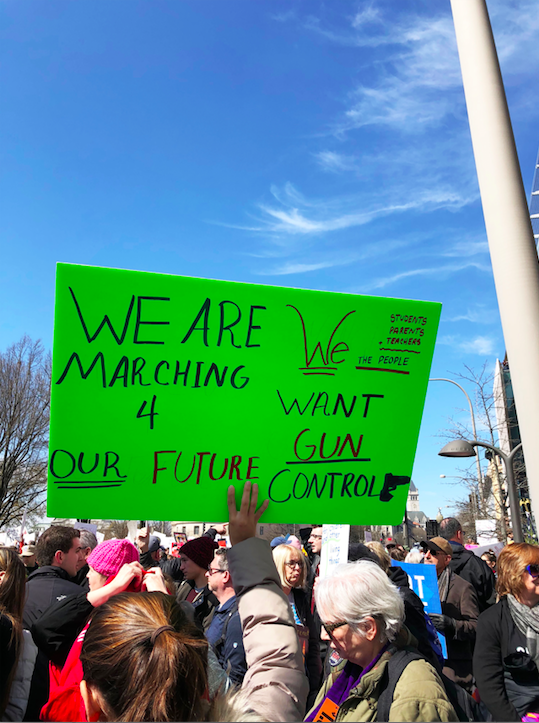In the shadow of the U.S. Capitol, 800,000 people stood strong. We sang songs, cheered, and shed tears. All of this, we did together. The sun burned bright, welcoming a lively crowd and a group of precocious children. An introductory video flashed across jumbotrons, a fitting opening number for the acts of civil discourse that were soon to follow. As students took center stage, adults were relegated to the role of supporting cast. After years of waiting in the wings for their chance to shine, our nation’s youngest are finally ready to take the lead.
A thick skin and media savvy have allowed the students of Parkland, Florida to remain in the news cycle. In the face of critics peddling “crisis actor” rumors, among others, Marjory Stoneman Douglas students have yet to demonstrate how their youth precludes them from having a voice in our society. The massive demonstration these high school students pulled together in a matter of weeks is nothing short of inspiring. Using various social media platforms and a stiff upper lip, Stoneman Douglas students, rather than professionals, organized the march. They haven’t just kept the spotlight on their town, their school, and their grief alone. They pulled it straight from the fingers of lawmakers and the National Rifle Association (NRA) and back onto the issue at hand.
Organizing the march was just the first step in an incredible display of force and passion from our nation’s youth. Organizers sought to diversify the event by inviting students from across the country representing varying demographics. This concerted effort by march organizers brought much needed attention to African-American community, a group of people whose voices are often needlessly ignored on the issue of gun violence. However long it took for communities that are frequently under-covered and misrepresented in the media and our society to get the recognition they deserve, there can be no denying that including them in the march was a powerful statement and yet another small step in the right direction.
There were many moments at the march where I could not help but feel chills run down my spine. Between Emma Gonzalez’s tear-stained silence as she relived the Parkland shooting down to the second, or 11-year-old Naomi Wadler who proved you can never be too young to start your activism career, or 9-year-old Yolanda Renee King who is the granddaughter of Civil Rights legend Martin Luther King Jr., or any one of the countless moments throughout the day that tugged on the heartstrings. Yet, one speaker who was a standout was Zion Kelly, a young D.C. teen whose brother was shot and killed by a robber. He stood and delivered this stirring opening to his speech: “I’m here to represent the hundreds and hundreds of thousands of students who live every day in constant paranoia and fear on their way to and from school.” Kelly’s message throughout his speech was simple. You must honor those you have lost, but there comes a time when action must be taken. It is your duty. He challenged everyone at the march to fulfill that duty. Each of these extraordinary young people knows first-hand what being a victim of gun violence feels like. Each of them knows, in one way or another, the feeling of being ignored solely based on the color of their skin, their sexual orientation, their age. They’ve had enough. They accept the challenge.
Many of the speakers stood defiant, staring down the NRA and Congress with disdain. They spoke from a place of deep frustration that was well-placed and obvious. Fed up with the NRA’s message that mental health is the only problem worth focusing on, the Parkland students refused to hold back and mince their words. Though the NRA bore the brunt of the speakers’ denunciations, the U.S. Government did not make it through the day unscathed. Many of the speakers took to passionately criticizing Congress for its inaction, calling for better leadership.
Under all of the anger and resentment was a rallying cry determined to galvanize young people. Each speaker spoke from the heart, the pain on their faces ever-present and almost tangible to the crowd beneath them. Ryan Deitsch was that cry incarnate: “We cannot make America safe again until we arm our teachers.” Silence and confused looks were rampant, followed by a smattering of “boos” as marchers looked up, shocked. Deitsch continued, “We need to arm them with pencils, pens, paper, and the money they need to support their families and to support themselves before they can support the futures in those classrooms. To support the future that sits down at that desk waiting to learn.” The crowd turned electric, erupting into a roar as we realized what was happening. Yet another high schooler had injected the crowd and young people across the nation with the fire and passion necessary to affect meaningful change.
The students of Stoneman Douglas had one goal on march day: to keep the focus on meaningful gun reform while rising above the numerous political pundits who trivialize and dismiss the movement. They accomplished that and then some that day. With fiery speeches, a quiet fortitude, and grace, members of our youngest generation have taken the world by storm. They keep their heads held high, their hearts set on a message of reassurance rather than divisiveness, and all the while never wavering in the face of steady criticism and ridicule. In the shadow of the U.S. Capitol, 800,000 people stood strong. Every single one of them embodying the simple proclamation delivered earlier in the day by Cameron Kasky, “Don’t worry, we’ve got this.”









